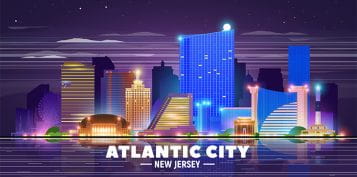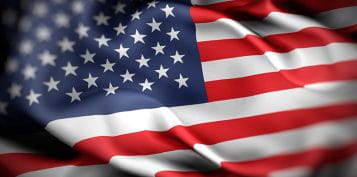Las Vegas History – Creation of LV, The Strip & Fun
The Las Vegas history stretches back to the prehistoric era, but we will focus on the ages of gambling and wagering. We will tell you how Las Vegas, the railroad town, become Las Vegas, NV – the great gambling city. Explore this blog post to learn which were the best casinos and hotels through the ages, when gambling was legalized and more about the history of Las Vegas Strip.

Knowing when was Las Vegas founded is important if you are a history buff. This article mainly focuses on the gambling history of Las Vegas, Nevada. We will tell you about the great hotels and casinos built through the decades of the past century and what entertainment they offered to their guests. Don’t miss to read the FAQ section at the end, and now, here are the main sections of this blog post:
Before Las Vegas Existed
The history of Las Vegas starts long before the construction of the first casino. In this first part of the article, we will take you down on a quick stroll through ancient times. We will begin with the thriving prehistoric life in Las Vegas Valley. The Tule Springs Fossil Beds National Monument shows that during Las Vegas’ early history, the entire Southern Nevada was covered with marshes.
When humans found their way to this land about 10,000 years ago, they brought their games and lifestyle. This was far from the comfort and flashy entertainments of the modern Native American casinos, but it was part of daily life. History museums have many game pieces, bone dice, and other artefacts used in various ancient games.
When the Vikings (lead by Leif Erikson) and the Europeans reached the new land, they brought their betting and fun games. In just a few centuries, dice and card games became a common entertainment at the saloons for gunslingers and outlaws like Wild Bill Hickok, Doc Holiday, Poker Alice, and more.
The Creation of Las Vegas, Nevada

Now that you learned what was the early history of Las Vegas, Nevada, is time to turn your attention to the last couple of centuries. Below, you will read how and why Las Vegas was created. Perhaps this is a good moment to mention that several interesting events and decisions led to the city’s founding.
Las Vegas Settlement
Our Las Vegas history tour began in 1829 when Rafael Rivera named the area Las Vegas (“the meadows” in Spanish). It became a common rest stop for travellers from New Mexico to Los Angeles. The San Pedro, Los Angeles, and Salt Lake Railroad bought the land and built the railroad. The new Mormon settlers renamed the area Clark County and devoted the next decades to agriculture and irrigation of the arid land.
When Was Las Vegas City Founded?

The history of Las Vegas city begins on May 15th 1905, when the railroad passed through the 110 acres town of Las Vegas, Nevada. In 1906 the Las Vegas hotel history began with the construction of Nevada Hotel, the first Las Vegas hotel, and in 1910 the Victory Hotel opened its doors. Fans of history and old Las Vegas hotels can stay at Nevada Hotel (renamed to Golden Gate Hotel & Casino Las Vegas in 1955).
1910 was also important for gamblers because around midnight on October 1st, 1910, the Nevada anti-gambling law came into power. The history of gambling in Las Vegas shows that this ban was so severe that even flipping a coin was a crime. The following years led to the railroad bankruptcy, and the town fell into a horrible economic state that continued throughout the great depression.
Creation of the Las Vegas Strip

The history of Las Vegas shows that the city has survived many calamities and problems. Many of the local casinos in Las Vegas played major roles in keeping the city alive. The family fun destination we know today was in a dire state a century ago, but many industrious people decided to risk, take the opportunity and make things better.
1930s: Legal Gambling & First Licensed Casinos
Even though in 1931, the divorce laws in the state changed to allow quick divorces, which was an important change, many people were more interested in the legalization of gambling in Nevada. Not long after that, the owner of Northern Club, Mayme Stocker, received the first Nevada gaming license, and the first LV casino Pair-o-Dice Club opened on Highway 91.
1940s: Liberace & Creation of The Strip
The history of Las Vegas, Nevada, shows that, unlike most cities during the Great Depression, Las Vegas had a population boom. This led to the construction of many new community, entertainment, and army buildings like The Las Vegas Army Air Field (built in 1941 and Nellis Air Force Base in the present day).
The growing entertainment business in the 1940s shaped the initial lines of The Strip. The first themed resort in Las Vegas was El Rancho Vegas hotel‐casino (1941), followed by the construction of El Cortex (1941), Hotel Last Frontier (1942, the old Pair-O-Dice nightclub), Flamingo (1946), and Thunderbird (1948). The first live shows were introduced, and one top-ranking was Liberace’s performances from 1936 until 1986.
1950s: Gangsters & Gambling

The Las Vegas mob history is extremely eventful during the 1950s. In the history of Las Vegas Strip, this is the time when many famous Las Vegas mobsters like Bugsy Siegel, Will Max Schwartz, and Anthony “Tony the Hat” Cornero invested in the casino business and partnered up with local businessmen like Moe Dalitz. The fresh money led to the creation of many entertainment locations and casinos:
| 📅 Year | ⭐ Casino Established |
|---|---|
| 1950 | Desert Inn Casino |
| 1951 | Binion’s Horseshoe Casino |
| 1952 | Sahara Hotel and Casino, Sands Hotel and Casino |
| 1953 | Riviera Hotel and Casino |
| 1955 | Moulin Rouge |
| 1956 | Fremont Hotel |
| 1957 | Tropicana on The Strip |
Frank Sinatra performed for 43 years in the top casinos on the Las Vegas Strip map alongside Liberace, Dean Martin, Andy Williams, Bing Crosby, and more. The Desert Inn even managed to make a spectacle of the first atomic bomb detonation at the Nevada Test Site on January 27th, 1951. The visitors to the Sky Room restaurant were treated with Atomic Cocktails as they observed the mushroom clouds.
The decade ended happily with the creation of the Gaming Control Act of 1959 and the establishment of the Nevada Gaming Control Board. This solved the problem with illegal gambling dens and opened more opportunities for licensed casinos. This was also the year when the “Welcome to Fabulous Las Vegas” sign was constructed.
The Constantly Growing City of Las Vegas, Nevada
After the gangsters were cleared away or managed to transform into descent businessmen came the time of bright lights and glamour in Las Vegas history. People of all statuses flocked to the tables and did their best to look their best as they used the modern gambling terms.
1960s: Celebrities & Spies Replace the Mobsters
After the mobsters left, charming spies and dreamers took their place. The casino adventures of the MI6’s 007 agent James Bond excited the public and inspired Las Vegas operators to notch up the shows with celebrities like Tom Jones, Wayne Newton, and Elvis.
The Aladdin and Caesars Palace construction in 1966 and the Circus Circus in 1968 showed that times are changing. Another great sign was the world’s first female stand-up comic, Phyllis Diller. She performed from November 1964 until 2002, and her gambling jokes are some of the best you can hear.
1970s: “Viva Las Vegas!”
In the 1970s, the focus of gambling was turned toward live shows. This is the time when many people began visiting Las Vegas for entertainment and did not focus on the gambling phrases or gaming. Some of the most notable performers of that time were the talented and sexy ladies Charo and Lola Falana, who dazzled the spectators with their dances and songs.
The secret history of Las Vegas has more details about the absolute success of Elvis Presley. The 21-year-old King of Rock ‘n’ Roll made his first appearance in Vegas in 1956, but the real success came a decade later. From 1969 to 1976, Elvis Presley scored 837 consecutive sold-out performances at the International Hotel. Unfortunately, 8 months after his last show, Elvis’ heart failed.
1980s and 1990s: The Family Vacation Destination
After a century of dangerous mobsters, hippie revolutions, glamour, and celebrity live shows, the history of Las Vegas, Nevada, takes a turn to calmer waters. The last decades of the 20th century marked the beginning of the transformation from gambling to a family-friendly destination, and there are even many pet-friendly hotels in Las Vegas.
In 1981, Dolly Parton had her debut at the Riviera, and the “Jubilee!” burlesque show was on everyone’s must-visit list. The middle of the 1980s marked unprecedented city growth, and the population almost doubled until 1995. In the 1990s were established many of the following top-rated family-friendly hotels in Las Vegas:
- ⭐ 1989 The Mirage
- ⭐ 1990 Rio, Excalibur
- ⭐ 1993 MGM Grand, Treasure Island, and Luxor
- ⭐ 1995 Hard Rock Hotel and Casino, Fremont Street Experience
- ⭐ 1996 Stratosphere Tower, Monte Carlo
- ⭐ 1997 New York-New York
- ⭐ 1998 Bellagio
- ⭐ 1999 Mandalay Bay, Venetian, and Paris
During the 1990s, Hollywood did not waste time and informed the vast public about the change in its ways. Many gambling-related and Vegas-located films flooded the theatres. Some of the most notable names are National Lampoons Vegas Vacation (1997), Rain Man (1988), Casino (1995), Fear and Loathing in Las Vegas (1998), and more.
The most famous live shows in this part of the history of Las Vegas were performed by magicians like David Copperfield, Siegfried & Roy, and Cirque du Soleil. One of the most notable nights was Mike Tyson vs Evander Holyfield’s fight in 1997 when Tyson bit off Evander Holyfield’s ear during a boxing match at MGM Grand.
Las Vegas Nevada Today & Heading to the Future

Considering when was Las Vegas founded, we can’t wonder what would have happened if Rafael Rivera had kept travelling instead of taking a rest in the meadows in 1829. Perhaps, in this case, we would not be wondering how long is the Las Vegas Strip or what is the next great show we can attend. Knowing the history, it is time to look at the future of the city beyond the “Welcome to Fabulous Las Vegas” sign.
During the new Millennium, the 4.2 miles (6.8 km) long Las Vegas Strip continued to change lives, inspire, and become a centrepiece of movies like Ocean’s Eleven (2001). The Las Vegas casino history added new resorts and casino hotels welcoming guests from around the world:
- ⭐ 2000 Planet Hollywood (Formerly Aladdin)
- ⭐ 2001 Palms
- ⭐ 2005 Wynn
- ⭐ 2007 Palazzo
- ⭐ 2008 Encore
- ⭐ 2009 CityCenter (Mandarin Oriental/Waldorf-Astoria, Vdara, and Aria)
- ⭐ 2010 The Cosmopolitan
- ⭐ 2013 Sahara Hotel (reopens as SLS Las Vegas, and again becomes Sahara in 2019)
- ⭐ 2014 The Linq
- ⭐ 2018 NoMad Hotel
- ⭐ 2020 Circa Resort & Casino (first new downtown resort in 40 years)
- ⭐ 2021 Virgin Hotels Las Vegas (former Hard Rock Hotel), Resorts World Las Vegas (former site of Stardust)
The history of the Las Vegas Strip shows that 30 of the world’s best casinos and hotels are here and offer gambling, luxurious accommodations, and live shows by international stars like Celine Dion, Prince, Penn & Teller, Elton John, Cher, and more. Besides dazzling glamour, the visitors can also find many cheap hotels in Las Vegas with great services.
One of the Las Vegas history facts is that the COVID-19 pandemic (started in 2020) almost bankrupted many casinos and closed many businesses. The mass cancellation of events also influenced the entertainment business, but the operators quickly found solutions to the problems. Las Vegas is running full speed ahead and ready to deliver more gambling opportunities, live shows, and fun than ever before.
Las Vegas History Interesting Questions
There are so many secrets in Las Vegas history that we will never discover them, even if we try. Instead, we collected several interesting questions related to Las Vegas gambling, casinos, hotels, and entertainment. Check out the answers and follow the links to learn more.
Similar Articles


